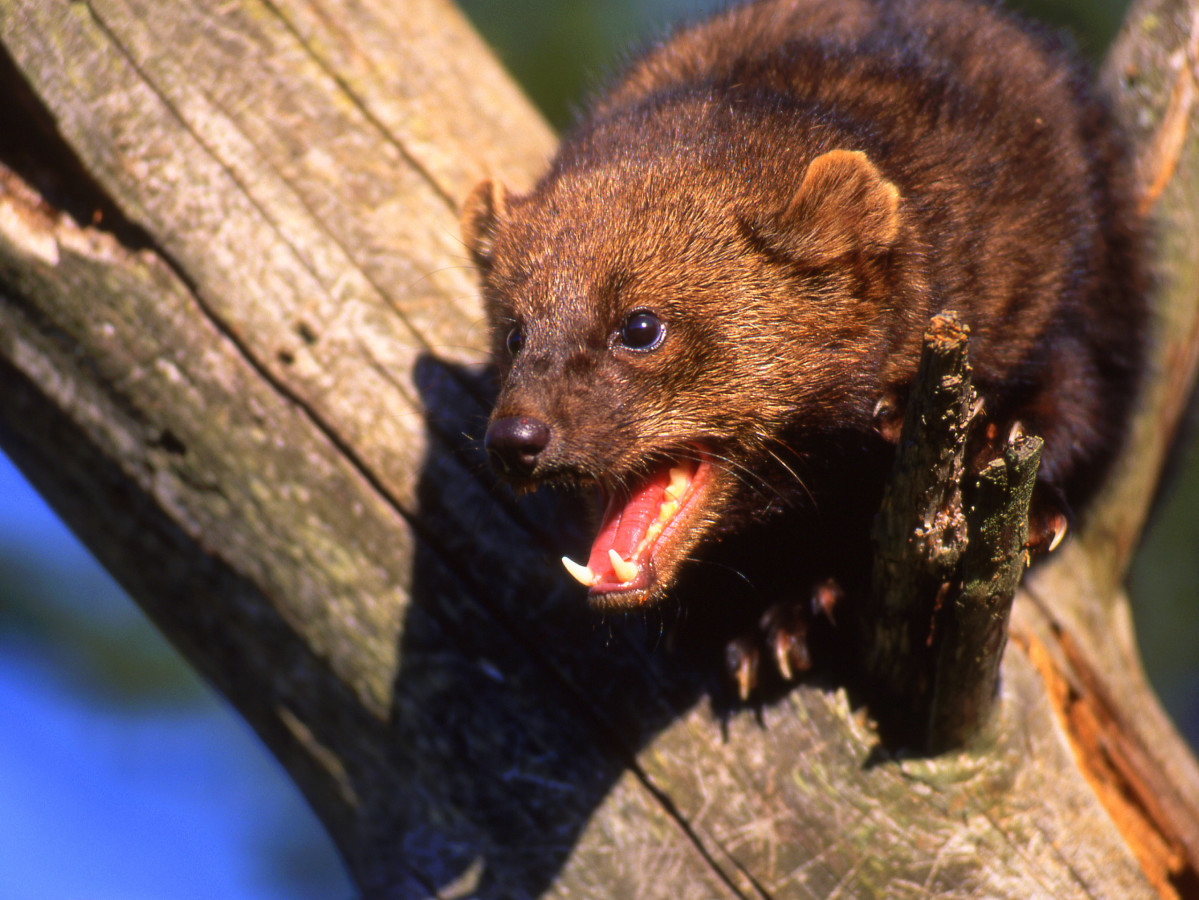When former Land Trust President Tom Reimers found evidence of bears on his property in the town of Danby, he set up a motion-sensing camera to confirm his suspicions.
The camera hasn’t succeeded in photographing any bears yet, but last summer it captured a picture of a fisher (Martes pennanti). The photo shows a large, dark animal, something like a cross between an otter and a large cat, strolling nonchalantly across the forest floor.
Fishers, sometimes called “fisher cats,” may look vaguely feline, but in fact they are mustelids – long, sinuous, fierce members of the weasel family. Thanks to its varied habitat, upstate New York is unusually rich in mustelid species: otters swim in the waterways; mink hunt at the water’s edge; weasels live in the uplands and hedgerows; martens are adapted to deep snow at higher elevations; fishers inhabit old-growth coniferous forests.
That, at any rate, was the received wisdom about fishers, but it turns out to be only partially correct. Like so many other North American animals, fishers almost went extinct in the nineteenth century as the forests were clearcut and the animals themselves were indiscriminately trapped for their dense, glossy fur. When it was all over, the only fishers left in the state were in the Adirondacks. Adirondack fishers were live-trapped and released into the Catskills in the late 1970s, where they flourished. Because the animals were only found in undisturbed wilderness, biologists wrongly assumed that they could only survive in old-growth forests.
This misconception persisted until fisher sightings began trickling in from all over the state, from Albany to western New York. DEC wildlife biologist Lance Clark saw his first fisher in the mid-90s in Bear Swamp State Forest in Cayuga County; a roadkilled animal turned up in Onondaga County at about the same time. Beginning in 2007, naturalist Linda Spielman has found fisher tracks in Tioga and Tompkins Counties.
Fishers, it turns out, are a lot more adaptable than anyone had expected. As largely arboreal predators, they will not live in treeless areas, but they do not seem to be bothered by most human activities and have made themselves at home in many areas throughout the northeast. In fact, so-called “edge habitats”– areas at the junctions between distinctly different habitats, especially forest and field – are particularly attractive to fishers because they are home to high populations of the small mammals that are their primary prey. Fishers aren’t picky, however: they will eat amphibians and reptiles, birds, eggs, insects, carrion, and even berries and acorns.
They are also one of the few animals that dare to prey on porcupines. A fisher will repeatedly attack the porcupine’s face until it weakens and can be flipped over for a kill. In some cases, they can force porcupines to fall out of a tree and then attack their stunned prey on the ground.
As marginal farmland reverted to woodland in recent decades, most of upstate New York turned into potential fisher territory. Fishers were reintroduced into Pennsylvania in 1994 and, combined with populations from West Virginia, are now dispersing into western New York. Animals from both the Adirondacks and the Catskills are colonizing central New York, including the Finger Lakes forests.
In fact, fishers are in the process of reclaiming many parts of their former range. When they were eradicated in Vermont, porcupine populations skyrocketed; the forests didn’t get a break from those voracious bark-eaters until Maine fishers were imported to control them. Vermont fishers then moved into New Hampshire and Massachusetts, and have recently even been spotted just outside of Boston.
There have been many sightings of “black panthers” in upstate New York. Panthers, or cougars, were long ago extirpated from the state and, in any case, are never black. If you see a “black panther,” it is most likely a fisher. At approximately three feet long, the animal may look formidable, but even a very large specimen rarely weighs more than fifteen pounds. Unlike cougars, these animals are no danger to human beings, but forest-dwelling owners of free-ranging cats and poultry would be wise to take appropriate precautions.
Angie Berchielli, a trapper and naturalist who assisted in the efforts to restore fishers to the Catskills and Pennsylvania, is excited by the growing fisher population. “It is truly one of the greatest success stories [showing] what very good management of a species by the DEC can do. They are now available for all of us, whether we are trappers, photographers, or people who just like to watch wildlife.”
The NYS DEC is collecting information about fishers. Please report any sightings to fwwildlf@gw.dec.state.ny.us.


